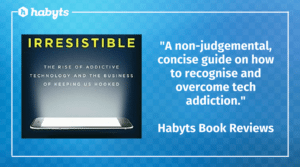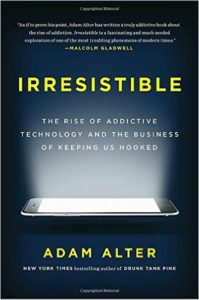
“Can you explain why you’d give a one year old an iPad?” Yes, Adam Alter can.
As he so accurately summarizes in his new book Irresistible, iPads make the job of parenting seem much easier (at least in the heat of the moment).
So, we read his book to summarise the key points we loved and what parents can take from Adam’s view of technology and addiction, so you can decide whether you want to read it too.
Review: A non-judgemental, concise guide on how to recognise and overcome tech addiction
As Adam navigates the world of addiction with a series of real-life anecdotes, he makes a strong argument for why we should consider technology addiction as seriously as substance addiction.
Just because tech is mainstream doesn’t mean it is any less likely to become an addiction or devalue the term. In Adam’s own words, “just because drugs produce a stronger reaction than behaviours doesn’t mean the pattern isn’t the same.”
With most people’s daily tech usage 50% higher than they think and the majority of people losing almost 100 hours each month to screen time, we can’t ignore the fact that we are addicted to our phones.
Here’s a fun little Internet Addiction Test that Adam includes in his book:
Select the response that best represent the frequency of each behaviour.
Scale:
- 0 – not applicable
- 1 – rarely
- 2 – occasionally
- 3 – frequently
- 4 – often
- 5 – always.
Questions:
- How often do you find that you stay online longer than you intended?
- On average, how often do others in your life complain to you about the amount of time you spend online?
- How likely are you to check your email before something else that you need to do?
- During a week, how often do you lose sleep because of late night log-ins?
- Do you find yourself saying “just a few minutes” when online? How often?
Score:
7 or below: You show no signs of an internet addiction
8-12: Mild internet addiction, but you’re generally in control of your usage
13-20: Moderate internet addiction, causing you “occasional or frequent problems”.
21-25: Severe internet addiction, causing significant problems in your life
Whatever your score, Adam makes a good point in the book. Abstinence is a lot to demand when screens are everywhere. We can’t escape technology. So should we embrace it, limit it or abandon it?
What to expect in this book

First, Adam wants us to understand behavioural addiction. What it is and where it came from. Remarking on how scientists once marveled at cocaine the same way we marvel at the benefits of tech, Adam talks us through the history of addiction. He summarises that it is produced largely by environment and circumstance.
And as we all know, we’re already seeing the effects. Kids are picking up parent’s attention patterns, sleep quality is declining and the dopamine effect has made video games particularly addictive.
A large part of the book focuses on the ingredients of behavioural addiction:
- Goals, and how obsessed we’ve become with tracking and completing them
- Feedback, and the dopamine we get from positive reactions and reinforcements
- Progress, how humans are naturally driven by it
- Escalation & hardships, how they heighten our success & keep us from being bored
- Cliffhangers, and how we’re driven by knowing what happens next
- Social interaction, how if we don’t learn in the right environment, we will miss the cues.
Each of these parts is well worth the read and a discussion in their own right. Perhaps we will do them as their own blog posts in time. For now, though, we want to move onto the heart of Adam’s book, Irresistible.
Overcoming addiction
Throughout the book, Adam uses real-life examples where people have overcome both substance and tech addiction and shares with us with a number of interesting findings.
Abstinence doesn’t work

Adam gives a great example of this. He asks us for 30 seconds to avoid thinking about chocolate ice-cream. Except how can you measure how successful you are at this unless you compare your thoughts to the one you are not allowed to have? You have to think about chocolate ice-cream to know whether you were thinking about chocolate ice-cream a minute ago.
I don’t is more powerful than I can’t

Again, there is a simple but powerful explanation. “I can’t” is disempowering. It’s giving its power to an unknown entity. Like a child, we’re all drawn to do things we’re told we cannot do. “I don’t”, on the other hand, is an empowering declaration. It gives you the power to decide what you do.
The findings? When presented in an experiment, only 10% of respondents stuck to their goals when they said “I can’t”, whereas 80% of “I don’t” respondent’s’ stuck to their goals.
A well-designed environment encourages good habits and healthy behaviours

It’s almost impossible to overcome an addiction with sheer force of will. In fact, those who are forced to exercise willpower fall first, while those who avoid temptation fair much better.
For example, say you’re addicted to chocolate chip cookies. Willpower is about looking at them and refusing them (let’s face it, how many of us would do that?). A good habit, however, ensures you’re rarely around those cookies in the first place.
By designing temptation-free environments and blunting unavoidable temptations, you give yourself a tool for doing more of the right things.
So where do we begin when it comes to technology at home?
As Adam quite rightly points out, these experiences are so new to us that we aren’t sure where to begin. Throughout the book, he focuses on how elimination can help addiction. But as we know, it’s impossible to eliminate screens from your life entirely.

Therefore, Adam’s alternative solution is to harness the positive effects of technology.
He believes we can channel the forces that drive behavioural addiction for good. Gamification, which includes many of the ingredients of behaviour addiction: goals, feedback progress and escalation, can encourage us to do the right thing if created properly.
Because while we know negative feedback can influence kids behaviour (being told off, losing pocket money…etc.), they’re motivated to do good when given a positive influence. Technology can solve our tech problem, as long as it offers positive reinforcement.

That’s why Habyts is designed to reward kids who complete chores and homework before using their play time. To motivate them into good habits, rather than just telling them when they can’t have screen time.
Of course, there is a fine balance. Not everything should feel like a game, which is why it’s still important that we are having these tech discussions with our kids. They need to understand it’s not just about limiting their screen time but improving their overall well-being and development.
If behavioural addiction is something you are concerned about when it comes to your child’s life with technology, we highly recommend reading Adam Alter’s book, Irresistible.
In the meantime, we have a great blog on how to start the tech conversation with your kids and our own guide filled with practical tools on how to help your child with their technology addiction.
To get an even better idea of what Irresistible is all about, check out this Ted Talk with Adam!
Do you have a book recommendation for us? Get in touch below!